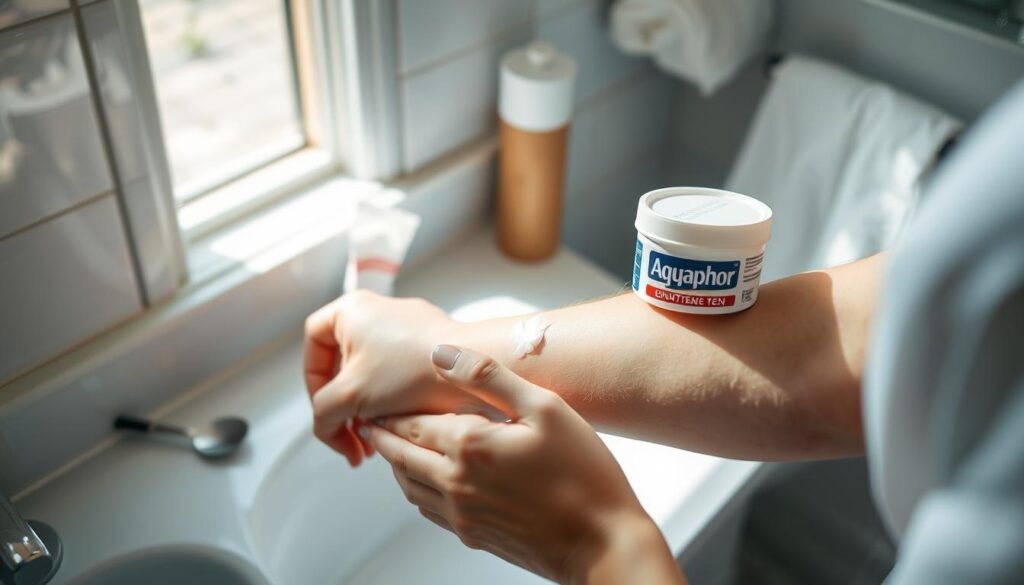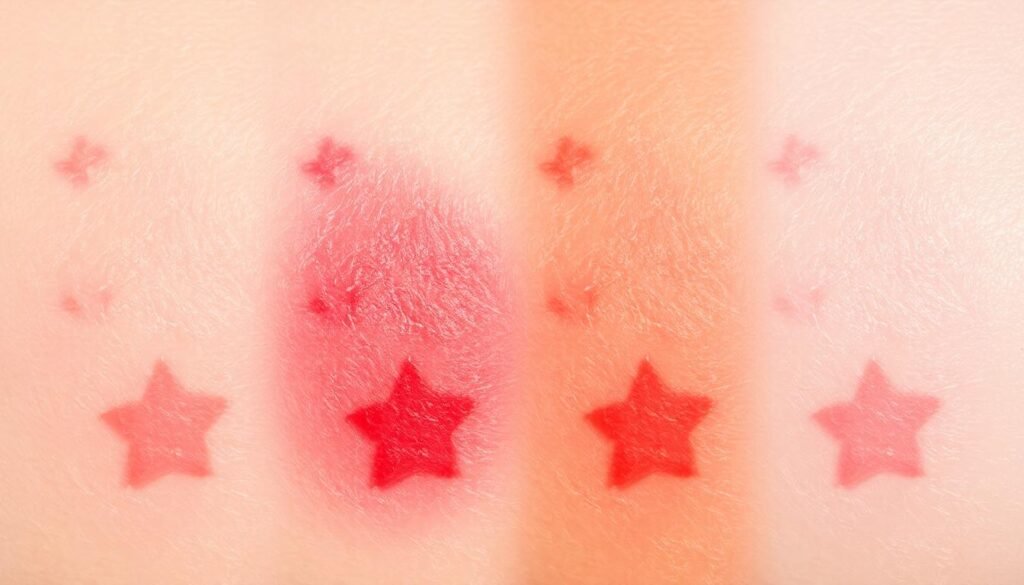Going through surgery recovery can be scary and uncertain. Every scar is a story of strength. It’s important to take care of the healing process for both body and mind.
This guide looks at using Aquaphor for surgical scars. We’ll share tips on wound care after surgery. Aquaphor can be a big help, keeping your skin moist and safe while it heals.
If you’re getting ready for surgery or are healing now, knowing about Aquaphor can help a lot. We want to give you the knowledge to heal well and reduce scars.
Key Takeaways
- Aquaphor creates a protective barrier that supports wound healing
- Panthenol in Aquaphor aids in skin regeneration
- Proper application can significantly reduce scarring risks
- Consistent care is key for the best surgical wound recovery
- Always get advice from a doctor during healing
Understanding Post-Surgical Scar Formation
Surgical wounds are complex and change our skin’s look. Each scar has its own healing story. Knowing how scars form helps patients care for their skin better after surgery.
Our body starts healing right after surgery. Many systems work together to fix the damaged tissue.
The Biology of Scar Formation
Scar formation goes through several stages:
- Inflammatory phase: Immune cells rush to the wound site
- Proliferative phase: New tissue and blood vessels form
- Remodeling phase: Collagen restructures for optimal healing
Types of Surgical Scars
Scars from surgery can look different:
| Scar Type | Characteristics | Occurrence Rate |
|---|---|---|
| Normotrophic | Flat, minimal raised tissue | 60-70% |
| Hypertrophic | Raised, confined to wound area | 15-20% |
| Keloid | Extends beyond original wound | 10-15% |
Factors Affecting Scar Development
Many things can affect how scars form:
- Genetic predisposition
- Skin type and pigmentation
- Age and healing capacity
- Wound care techniques
- Nutritional status
“Proper wound management can significantly reduce scarring risks and improve healing outcomes.” – Dermatological Research Institute
Aquaphor post-surgery skin care is key in managing healing. By understanding scar formation, patients can make better choices for their recovery.
What Makes Aquaphor Effective for Surgical Scars
Aquaphor Healing Ointment is a top choice for preventing and treating surgical scars. It has special ingredients that help wounds heal well. The ointment acts as a shield, protecting sensitive skin from harm while keeping it moist.
What makes Aquaphor work so well? It’s because of its special ingredients. Panthenol, a key part, helps wounds heal by:
- Promoting skin regeneration
- Reducing inflammation
- Enhancing moisture retention
- Protecting delicate healing tissue
“Aquaphor provides an optimal environment for surgical wound recovery,” states leading dermatological research.
Studies show that Aquaphor is great for scars. Its petroleum-based formula keeps moisture in and lets skin breathe. This helps wounds heal naturally and avoids problems during scar prevention.
Dermatologists say Aquaphor is safe for sensitive skin. It’s hypoallergenic, making it good for many patients. This makes it a trusted choice for caring for wounds after surgery.
Is Aquaphor Good for Surgical Scars: Expert Analysis
To understand if Aquaphor helps with surgical scar healing, we need to look at research, medical views, and what patients say. We dive into the science behind Aquaphor’s role in healing surgical incisions and its benefits for scars.
Clinical Evidence and Research
Studies give us clues about Aquaphor’s effectiveness. A detailed review of 39 studies with 1,703 patients showed good results for wound healing. Key points include:
- 23 studies were classified as high-level evidence (Level 4)
- Wound healing remodeling phase can extend up to 1 year
- Aquaphor benefits for surgical scars include moisture retention and protective barrier creation
Medical Professional Perspectives
Doctors see the special benefits of Aquaphor in wound care. Its ingredients, like panthenol, are better than regular petroleum jelly. Experts suggest using Aquaphor for:
- Preventing scab formation
- Keeping the wound moist
- Helping wounds heal faster
Patient Success Stories
Real-life stories show how well Aquaphor works. People say their scars look better and heal faster with it. To use it right, apply it:
| Frequency | Duration | Application Method |
|---|---|---|
| 3-4 times daily | Up to 3 weeks post-surgery | Gentle, thin layer |
“Aquaphor transformed my surgical scar healing process, providing comfort and supporting rapid recovery,” shared a patient from a recent clinical study.
Note: Individual results may vary, and patients should always consult healthcare professionals for personalized wound care advice.
Aquaphor vs. Other Scar Treatment Options
Exploring aquaphor for post-operative scar management, patients find many treatment choices. We’ll compare Aquaphor with other leading scar minimization strategies to help you make an informed decision.
Our analysis shows key differences in scar treatment options. Dermatological research points out the advantages and limitations of each approach.
| Treatment Option | Effectiveness | Side Effects |
|---|---|---|
| Aquaphor | Moderate | Low |
| Medical-grade Silicone Gel | High | Minimal |
| Vitamin E | Low | High (33% contact dermatitis) |
| Corticosteroid Injections | Moderate | Multiple treatment sessions required |
Key insights for aquaphor and scar minimization include:
- Aquaphor shows moderate wound healing
- 52% patients experienced redness with Aquaphor application
- Medical-grade silicone gel is the most clinically supported option
Clinical studies show that choosing the right product for wound care is key. It depends on the individual’s healing process.
While Aquaphor has its benefits, patients should talk to healthcare professionals. They can help find the best scar management approach for their recovery needs.
Proper Application Techniques for Optimal Results
To get the best results from Aquaphor for surgical scars, you need to apply it carefully. Our guide will show you how to heal scars well and make them less visible.
Step-by-Step Application Guide
Applying Aquaphor right is key for managing scars. Here are the steps to follow:
- Clean your hands well before touching the scar area
- Use a sterile cotton swab or clean finger to apply
- Put on a thin, even layer over the scar
- Gently pat, don’t rub the ointment into the skin
- Don’t let the tube touch the wound to avoid germs
Frequency of Application
Is Aquaphor good for surgical scars? Yes, it is, if you use it right. We suggest applying it:
- 2-3 times a day
- After you clean the area gently
- After changing any dressings

Duration of Treatment
How long you need to treat a surgical scar depends on the healing stages. Here’s a plan that matches these stages:
| Healing Phase | Approximate Duration | Aquaphor Application Strategy |
|---|---|---|
| Inflammatory Phase | 3-5 days | Frequent, gentle application |
| Proliferative Phase | 5-15 days | Consistent twice-daily treatment |
| Remodeling Phase | Up to 1 year | Gradual reduction in frequency |
“Patience and consistency are the cornerstones of effective scar management.” – Wound Healing Specialists
Keep in mind, everyone heals differently. Always talk to your healthcare provider for advice on using Aquaphor for scars.
Essential Post-Surgery Wound Care Protocol
Effective aquaphor surgical wound healing needs a detailed post-surgery skin care plan. Our expert-recommended protocol helps ensure the best recovery and reduces risks.
Managing the wound right is key for healing. Our protocol covers important parts of aquaphor post-surgery skin care that patients must follow closely.
Essential Wound Care Guidelines
- Clean the surgical site daily with mild, fragrance-free soap
- Use lukewarm water for gentle cleansing
- Pat dry with a clean, soft cloth
- Avoid rubbing or aggressive cleaning
Moisture is key to optimal healing. Aquaphor creates a perfect healing environment by protecting and hydrating the wound.
| Care Aspect | Recommended Action | Duration |
|---|---|---|
| Wound Cleaning | Gentle soap, lukewarm water | Daily |
| Moisture Protection | Aquaphor application | 1-2 months |
| Dressing Changes | Based on drainage levels | 2-3 times daily (first week) |
“Proper wound care is the foundation of successful surgical recovery” – Dermatology Experts
Important precautions include avoiding pressure on the wound, watching for infection signs, and keeping up with wound care. Patients should look out for unusual discharge, too much redness, or swelling that could mean trouble.
- Wait at least 24 hours before removing initial dressings
- Apply Aquaphor gently to support healing
- Avoid picking at scabs or sutures
Our detailed approach makes sure patients get the best care for their surgical wound healing. This helps them recover well and reduces scarring.
Timeline for Surgical Scar Treatment with Aquaphor
Healing after surgery needs a careful plan for scar care. Knowing when to use Aquaphor can greatly affect your scar’s look and healing.
First Week After Surgery
The first week is key for treating scars with Aquaphor. It’s important to keep the wound clean and safe. Doctors usually suggest:
- Gentle cleaning of the surgical area
- Putting on a thin layer of Aquaphor to stop infection
- Avoiding the sun
- Keeping the wound moist but not too wet
Weeks 2-4 of Recovery
In this important time, scar prevention with Aquaphor gets more focused. Studies show that keeping the skin moisturized greatly helps healing. Important steps include:
- Starting gentle scar massage
- Applying Aquaphor 2-3 times a day
- Using soft, circular motions for massage
- Watching the scar for any odd changes
“Taking good care of your scar in the first month can really cut down on scarring,” says dermatology research.
Long-term Care Strategy
Scar care goes beyond the first healing stage. Our long-term plan is to:
- Keep using Aquaphor for up to 12 months
- Keep up with scar massage
- Stay away from the sun
- Check in with health experts now and then
Studies show that sticking to a scar care routine can lead to better-looking scars over time.
Common Mistakes to Avoid During Scar Treatment
Healing surgical scars needs careful attention and avoiding common mistakes. Our experts know that using aquaphor for surgical incision healing requires precision. They understand the errors that can harm wound recovery.
Patients often make mistakes in scar treatment that can affect healing. Proper wound management means knowing these risks.
- Never pick or scratch crusting areas around the incision site
- Avoid using hydrogen peroxide, which can damage skin cells
- Do not apply isopropyl alcohol that burns and irritates healing skin
- Prevent excessive moisture or complete dryness of the wound
“Healing is a delicate process that requires patience and careful attention.” – Wound Care Specialist
When using aquaphor for surgical scars, apply it gently and sparingly. Too much can block air and trap bacteria.
It’s important to understand your body’s healing signals. Pain-guided healing helps patients know when to stop activities that might harm healing.
Combining Aquaphor with Other Scar Management Methods
Aquaphor is key in managing scars after surgery. It works best when used with other treatments. Our experts say mixing methods is the best way to reduce scars.
Using Aquaphor alone is not enough for scar care. To heal faster, patients should try other treatments too.
Complementary At-Home Treatments
- Silicone scar sheets to reduce scarring
- Sunscreen (SPF 30+) to prevent sun damage
- Gentle massage to improve scar tissue
- Consistent hydration with Aquaphor
Professional Scar Treatment Options
For better scar care, you might need to see a professional. They can help with Aquaphor’s healing effects:
- Laser Resurfacing: Smooths scar texture
- Microneedling: Stimulates collagen production
- Dermabrasion: Reduces scar visibility
- Pressure therapy: Minimizes scar formation
“Combining multiple treatments offers the most promising approach to scar management” – Dermatology Research Institute
Our advice is to use Aquaphor with specific treatments for better scar healing. Everyone’s healing is different, so personalized care is key.
Signs of Proper Healing vs. Complications

Knowing how your scar heals is key when using Aquaphor. It helps you see if your scar is healing right or if you need to see a doctor.
Healing well means watching for certain signs. Aquaphor can help, but knowing what a healthy scar looks like is important.
Signs of Normal Healing
- Gradual reduction in redness and swelling
- Skin feeling soft and supple
- Minimal pain or discomfort
- Edges of the wound appearing clean and sealed
- Scar becoming flatter and less prominent over time
Warning Signs of Possible Complications
- Thick, yellowish discharge with an unpleasant odor
- Bright redness spreading beyond the surgical site
- Skin feeling excessively hot to the touch
- Significant increased swelling
- Persistent fever or chills
“Early detection of healing issues can prevent more serious complications in surgical scar management.” – Wound Care Specialists
If you’re wondering about Aquaphor for surgical scars, remember it helps but can’t replace a doctor’s check-up. About 8.2 million people in the U.S. face wound challenges, showing the need for careful watch.
If you see anything odd while your scar heals, talk to your doctor. Our team is here to help you get the best care for your scar.
Specialized Care for Different Types of Surgical Incisions
Surgical scars change a lot based on where they are and the surgery type. Our guide on aquaphor surgical wound healing explains the special care needed for each area.
Every surgical cut needs its own care plan. The healing time can change a lot based on where it is, the patient’s health, and how the surgery was done.
Facial Surgery Scar Management
Scars on the face need extra care because the skin is sensitive and easy to see. Treating them right is very important.
- Apply thin layers of Aquaphor to minimize scarring
- Protect facial scars from direct sunlight
- Use gentle massage techniques after initial healing
- Consider silicone strips for enhanced scar reduction
Body Surgery Scar Treatment
Scars on the body heal differently than those on the face. We adjust our care for each case.
| Body Area | Healing Characteristics | Recommended Care |
|---|---|---|
| Legs | Slower healing process | Elevation, compression, frequent Aquaphor application |
| Abdomen | Higher chance of stretching | Silicone strips, consistent moisturizing |
| Arms | Faster healing | Regular massage, sun protection |
“Proper wound care is the foundation of minimal scarring and optimal aesthetic recovery.” – Dermatological Research Institute
Knowing what each area needs helps patients use the right care for their scars. Our advice helps reduce scarring and promotes healing everywhere.
Long-term Scar Management Strategies
Managing surgical scars is more than just the initial healing. Aquaphor plays a key role in long-term care. It helps keep the skin looking and feeling its best.
Our approach to preventing scars involves helping the skin heal naturally. Scar development is a long journey, taking months to years.
“Consistent care is the key to minimizing surgical scar visibility and promoting healthy skin regeneration.”
Essential Long-Term Scar Management Techniques
- Perform scar massage for 10 minutes twice daily for 3-6 months
- Apply silicone therapy 12-24 hours daily for 3-6 months
- Protect scars from direct sunlight to prevent darkening
- Monitor scar progression and texture changes
Scar Progression Timeline
| Time Period | Scar Characteristics | Recommended Actions |
|---|---|---|
| 0-8 Weeks | Pink, raised, sensitive | Regular Aquaphor application |
| 2-6 Months | Potential thickening | Scar massage, silicone therapy |
| 6-12 Months | Gradual maturation | Continue monitoring, reduce intervention |
Experts say to keep using Aquaphor throughout the healing process. If scars are too firm, itchy, or growing abnormally, see a professional.
Professional Interventions
- Laser therapy for scar softening
- Microneedling after six weeks
- Potential surgical scar revision after one year
Every scar is different. Being patient and consistent is key to the best results.
When to Seek Professional Medical Attention
Aquaphor surgical incision healing needs careful watching. Most surgical scars heal well, but some need quick doctor visits. Knowing when to go to the doctor can stop problems and help healing.
It’s key to spot warning signs for better healing. Our medical team says to look out for these signs:
- Persistent redness beyond the incision
- Swelling or hardening at the site
- Unusual discharge or bad smell
- Sudden fever or high temperature
- Pain that doesn’t get better with usual treatments
“Early intervention can prevent serious complications and promote better healing outcomes.” – Wound Care Specialists Association
Some people need extra care. Those with diabetes, weak immune systems, or on immunosuppressants should watch closely.
| Risk Factor | Recommended Action |
|---|---|
| Uncontrolled Bleeding | Immediate Medical Attention |
| Signs of Infection | Contact Healthcare Provider Within 24 Hours |
| Abnormal Scar Formation | Schedule Professional Evaluation |
If you see any worrying signs, call our wound care team at (410) 252-9090. We’re here to help your surgical scar heal right and safely.
Advanced Scar Care at Our Florida Locations
Our clinics in Florida offer top-notch scar care services. We know that treating scars well goes beyond what you can do at home. Our team provides expert help in making scars less noticeable.
State-of-the-Art Treatment Facilities
We have advanced scar treatment centers all over central Florida. This makes it easy for patients to get the care they need. We focus on creating treatment plans that fit each person’s healing process.
- Orlando, FL – a full care center
- Clermont, FL – a specialized scar treatment place
- The Villages, FL – a rehabilitation clinic
- Kissimmee, FL – a center for advanced wound healing
- Ocala, FL – a scar management clinic
- Bushnell, FL – a recovery and treatment spot
- Belleview, FL – a specialized wound care facility
Contact Our Expert Team
Are you ready to start your scar treatment journey? Our medical team is here to help you with the latest scar care methods.
Professional Care, Personalized Results: Your Healing Matters
| Location | Specialty Services |
|---|---|
| Orlando | Comprehensive Scar Evaluation |
| Clermont | Advanced Laser Scar Treatment |
| The Villages | Personalized Scar Management |
| Kissimmee | Wound Healing Consultation |
Book your consultation today and start your journey to better scar recovery!
Conclusion
Aquaphor is a strong solution for those healing from surgery. It has petrolatum, mineral oil, and lanolin. These ingredients form a protective barrier that helps wounds heal well.
This barrier keeps wounds safe from bacteria and keeps them moist. This is key for a smooth recovery.
People looking into using Aquaphor for surgical scars will find it’s effective. Studies show it can make scars less visible and reduce tissue growth. Plus, it’s affordable at just $1.14 per ounce.
While Aquaphor is great for scars, it’s important to talk to a doctor. Everyone’s healing is different. A doctor can help create a treatment plan that works best for you.
Scar treatment is more than just a product. It’s about taking care of the wound, using the product right, and knowing what to expect. With the right approach and products like Aquaphor, healing can be supported.




